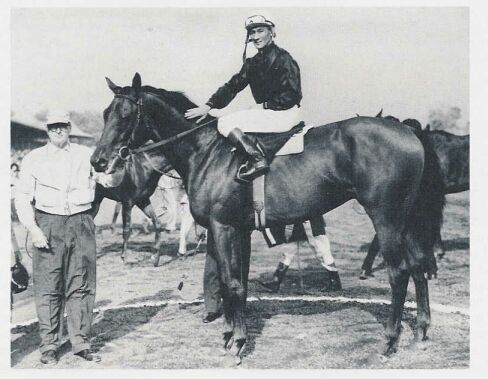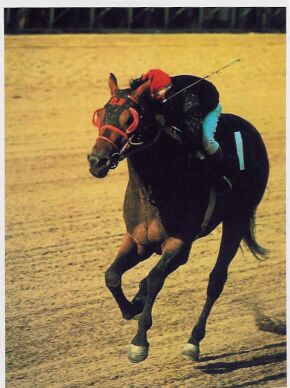

Few racehorses possess conformation that is good enough to be compared to that of Buckpasser. The well bred bay colt epitomizes everything horsemen seek with regards to appearance. The great painter Richard Stone Reeves said, "Buckpasser was the most perfectly proportioned thoroughbred I have ever seen." Only two horses, Secretariat and Affirmed, have since earned the high praise, "in a class with Buckpasser," from the artist in regards to their conformation. As New York racing official Dr. Manuel Gilman commented,
"Generally, every horse has about a hundred faults of conformation. I would defy anybody to pick a flaw in Buckpasser."
Equally faultless was the champion's disposition. Like his sire, 1953 Handicap Triple Crown winner Tom Fool, Buckpasser displayed the perfect manners that few Kings have equaled. He never made a false move, and when Richard Stone Reeves painted his Horse of the Year portrait, the horse gave the great artist the impression that had Buckpasser been able to talk, he certainly would have invited him into the stall, "offering a seat and perhaps a drink."
In the stable, the smallest child could have handled the great champion with ease, but once on the track, Buckpasser was a changed horse, and it was all jockey Braulio Baeza could do to hold him down to a canter as the field paraded to the post. Yet when he was on the lead, Buckpasser was inclined to loaf, seeming to enjoy taking the lead more than keeping it, and he preferred to score his victories with heart-stopping come from behind stretch drives that left his opponents almost too bewildered to crawl home behind him in stunned defeat.

Buckpasser was owned and bred by Ogden Phipps, and, like all the other champions bred by the Phipps's, he was born on the Hancock family's Claiborne Farm in Paris, Kentucky. His pedigree was pure gold, with 1953 Handicap Triple Crown winner and Horse of the Year Tom Fool as a sire, and War Admiral's Suburban Handicap winning daughter Busanda as a dam. Not only was Busanda by War Admiral, and therefore a granddaughter of Man o' War himself, but she was also out of a mare by Blue Larkspur, the 1929 Belmont Stakes winner and Horse of the Year. But perhaps the most influential of Buckpasser's royal ancestors was the two time Horse of the Year Equipoise, who sired Tom Fool's second dam Alpoise. Although he was a full four generations back in his famous descendant's pedigree, Equipoise passed many traits down to Buckpasser. During his career, Equipoise, nicknamed the "Chocolate Soldier" by his fans, was plagued by a chronic quarter crack, the same affliction which kept Buckpasser out of the 1966 Triple Crown races. Buckpasser's perfect conformation and disposition also came from the Chocolate Soldier, whose very name referred to his perfect balance and symmetry.
Always a gentleman, Equipoise visited the winner's circle after twenty nine of his fifty one starts, and his victories included the 1933 edition of the Suburban Handicap, a race which both Tom Fool and Buckpasser won in later years.
So, with a legacy almost impossible to live up to, Buckpasser began his racing career on May 13, 1965, running a poor fourth behind Lonely Gambler, who spent the rest of his days losing cheap claiming races. But never again did the mighty Buckpasser run out of the money. The next two times out he won with ease, and then in his first stakes race, the National Stallion Stakes, he came from a seemingly hopeless nine lengths behind to dead heat with a colt named Hospitality. He followed the partial victory with another impressive come from behind run, this time taking the Tremont Stakes while Hospitality ran third behind Spring Double. Apparently growing bored with his developing predictability, Buckpasser temporarily changed his style to score his next win by a margin of seven lengths, baffling even trainer Bill Winfrey.
Buckpasser was himself again in his next start, and with a brilliant late run he proved he was a top class horse by beating the favored Our Michael by a half length in Monmouth's Sapling Stakes.

With wins in the Hopeful Stakes and the Arlington-Washington Futurity, Buckpasser had eight triumphs to his credit when he met the outstanding filly Priceless Gem in the Aqueduct Futurity. The Gem took control immediately, and Braulio Baeza kept his mount close to her flying heels, fearing that the speedy filly would get so far ahead that even a powerful stretch drive from Buckpasser wouldn't be enough to catch her. Making his move in the backstretch, it took all Buckpasser had to bring his nose even with her shoulder, and Priceless Gem held on in the fierce stretch drive to win by a half length.
In his final race of the season, Buckpasser returned to New York and avenged the defeat in Chicago, winning the Champagne Stakes by four lengths while Priceless Gem finished seventh. The sore shins that the filly developed kept her from meeting another female star, the great filly Moccasin, who shared Horse of the Year honors with Roman Brother as a result of her undefeated season. Buckpasser was named Champion Two Year Old Colt, beating out Kauai King and Darby Dan's unbeaten star Graustark in the voting.
There were many changes for Buckpasser at the start of the 1966 racing season. Trainer Bill Winfrey was replaced by Eddie Neloy, who later said, "Buckpasser overcame all of my mistakes. That's a great horse." Also, their was a jockey change when Braulio Baeza, deciding that he would prefer to ride Graustark in the classics, was replaced by Bill Shoemaker. In his three-year-old debut, Buckpasser ran second behind his stablemate Impressive, who had been second in the previous year's Hopeful. Still another horse owned by the Wheatley Stable, a colt named Stupendous, finished third.
Now better acquainted, Bill Shoemaker and Buckpasser won the Everglades Stakes, which earned the bay colt the prestigious title of winterbook favorite for the Kentucky Derby, and set their sights on the Flamingo Stakes. Management at Hialeah, positive that Buckpasser would win and wishing to avoid losing money through the betting windows, declared the 1966 Flamingo Stakes to be a non-wagering event. New York sportswriter Red Smith dubbed it "The Chicken Flamingo," and as if to show track officials that no horse is a sure thing, Buckpasser chose that running of the Flamingo Stakes as one of the rare events in which he took the early lead. Once in front, Buckpasser became bored and shifted into neutral. Taking full advantage of Buckpasser's idleness, Abe's Hope made his move and took the lead. He was a full two lengths in front, and there was little doubt that the scene had induced the symptoms of heart failure in Hialeah's officials, when Buckpasser's interest in the sport of racing was restored. In a demonstration of explosive speed and power which left Abe's Hope gasping for breath, the great horse shifted back into high gear, and in a mere three strides he covered the ground which had stood between victory and defeat, winning the Flamingo in authoritative fashion.
Shortly after the awe inspiring triumph, Buckpasser developed a quarter crack, and the ailment kept him out of the Kentucky Derby. Graustark didn't make it to Churchill Downs either, and ended up retiring early when he broke his foot and ran second to Abe's Hope in the Blue Grass Stakes. That left Kauai King to win the Kentucky Derby and Preakness Stakes without much trouble, but he met with defeat in the Belmont, when Amberoid, trained by Lucien Laurin, won the last of the 1966 Classics.
On the same day that Amberoid won the Belmont, Buckpasser returned to the races, sprinting to an easy victory in a six furlong allowance race. He then beat Buffle, who later won the Suburban Handicap, in the Leonard Richards Stakes, and headed to Chicago for the Arlington Classic. Kauai King, running despite the furious protests of his trainer, broke down in the race and had to be retired. Buckpasser won the event, catching Creme dela Creme in the stretch and setting a new world record of 1:32 3/5 for a mile.
Buckpasser's almost endless stream of victories that season also included the American Derby, in which he broke the track record, as well as the Chicago Stakes, Brooklyn Derby, Woodward Stakes, Travers Stakes, Malibu Stakes, Brooklyn Handicap, Lawrence Realization Stakes, and the two mile long Jockey Club Gold Cup. The string of victories made Buckpasser the first horse to earn more than one million dollars before the age of four and he was named the 1966 Horse of the Year.
Buckpasser's four-year-old season began with a win in the San Fernando Stakes, but he was sidelined again with a quarter crack and missed four months of racing. When he returned, he scored his fifteenth consecutive victory in the Metropolitan Mile. In his first race on the turf, Buckpasser unsuccessfully tried to carry 135 pounds in the Bowling Green Handicap and finished third to his lightly weighted stablemate Porker.
Back on the dirt, Buckpasser gave away twenty-two pounds to the Widener Handicap winner, Ring Twice, in the Suburban Handicap. The lightly weighted Ring Twice had a two length advantage just eighty yards from the wire, and in a dramatic end to his most spectacular stretch drive, Buckpasser leapt past Ring Twice to win by a half-length. Only one race stood between Buckpasser and the Handicap Triple Crown, which his sire had worn fourteen years before. But in the Brooklyn Handicap, Buckpasser was beaten by the handicapper, running second to the lightly weighted Handsome Boy.
In the final race of his career, Buckpasser ran second to Damascus, who was later named the three-year-old champion and 1967 Horse of the Year, in the Woodward Stakes. World record holder and 1968 Horse of the Year Dr. Fager ran third.
Syndicated for $4,800,000, Buckpasser retired after the Woodward and stood stud at Claiborne Farm, where he was born. He sired La Prevoyante, the champion juvenile filly of 1972, as well as Numbered Account, the champion of the year before. An outstanding broodmare sire, his daughters include 1991 Broodmare of the Year Toll Booth, the dam of Champion Sprinter Plugged Nickle, and 1989 Broodmare of the Year Relaxing, the Champion Older Mare of 1981 and the dam of Belmont Stakes winner Easy Goer. Alluvial produced 1979 Belmont Stakes winner Coastal, as well as champion Slew o' Gold, winner of two Jockey Club Gold Cups, the Belmont Fall Championship Series, and more than three and a half million dollars. Numbered Account is the dam of Private Account, a major stakes winner and sire of the unbeaten mare Personal Ensign.

Daughters of Buckpasser have also produced European classic winner El Gran Senor, multimillionaire Seeking the Gold, Canadian Triple Crown winner With Approval, and the leading sire Woodman, sire of dual classic winner Hansel.
| Year | Starts | Wins | Seconds | Thirds | Earnings |
|---|---|---|---|---|---|
| Lifetime | 31 | 25 | 4 | 1 | $1,462,014 |
| Tom Fool | Menow | Pharamond II | Phalaris |
| Selene | |||
| Alcibiades | Supremus | ||
| Regal Roman | |||
| Gaga | Bull Dog | Teddy | |
| Plucky Liege | |||
| Alpoise | Equipoise | ||
| Laughing Queen | |||
| Busanda | War Admiral | Man o' War | Fair Play |
| Mahubah | |||
| Brushup | Sweep | ||
| Annette K. | |||
| Businesslike | Blue Larkspur | Black Servant | |
| Blossom Time | |||
| La Troienne | Teddy | ||
| Helene de Troie |




This text protected by all applicable copyright laws. Do not duplicate or distribute without written permission. © Spiletta42.